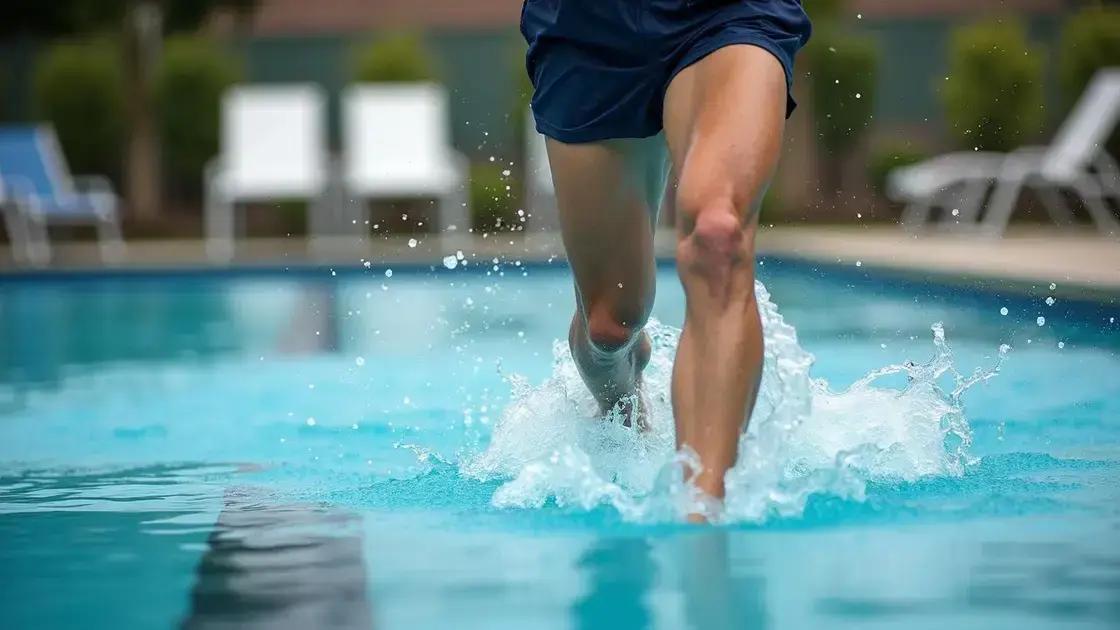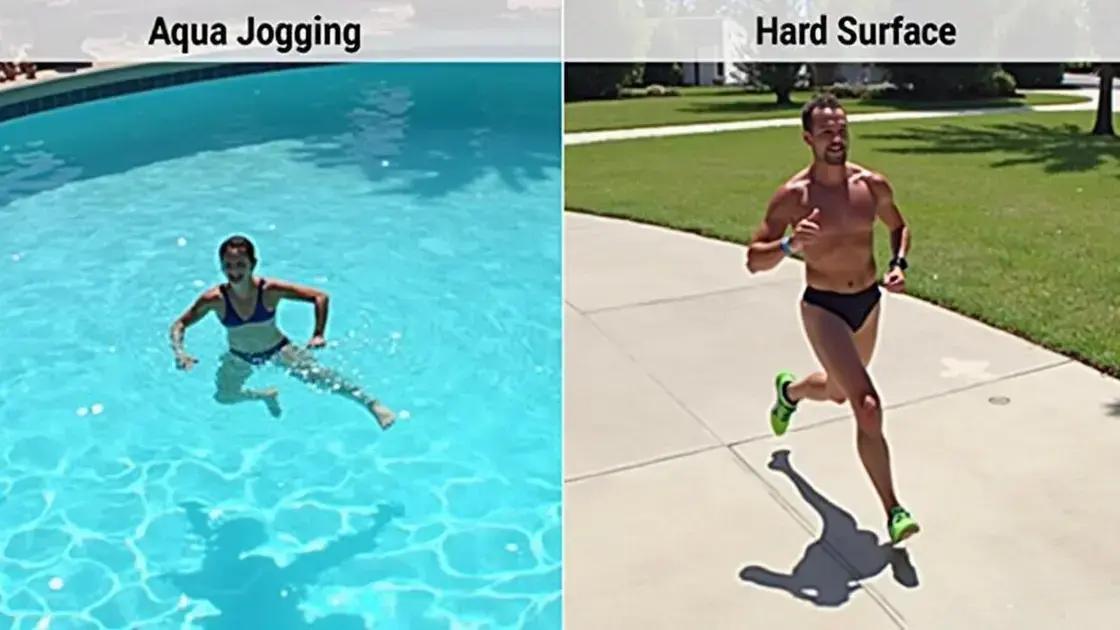Aqua jogging is a low-impact exercise ideal for improving cardiovascular fitness while protecting joints. It allows individuals of all fitness levels to simulate running in water, providing a safe option for those recovering from injuries or seeking a gentler workout. With benefits like muscle strengthening and effective calorie burning, aqua jogging offers a versatile routine for enhancing overall health.
Aqua jogging is an innovative exercise that allows you to achieve effective cardio workouts without stressing your joints. This low-impact exercise is perfect for people of all fitness levels, especially those recovering from injuries or seeking a gentler workout option. In this article, we’ll explore the various benefits of aqua jogging for low-impact cardio, including its unique features, health advantages, and practical tips to get started comfortably.
What is Aqua Jogging?

Aqua jogging is a unique form of exercise that occurs in water, using a special flotation belt to keep you afloat while you simulate the motion of running. This activity is often recommended for people who want to improve their cardiovascular fitness without putting too much strain on their joints. The water provides support, allowing you to work out more efficiently and prevent injuries.
How Does it Work?
During aqua jogging, individuals move their legs in a running motion while remaining in a vertical position in the water. The buoyancy of the water reduces impact on the knees and hips, making it an excellent option for those with injuries or chronic pain.
Who Can Aqua Jog?
Aqua jogging is suitable for almost everyone, including beginners, athletes, and those recovering from injuries. It offers a low-impact alternative to traditional jogging or running on land while still providing a solid workout. Physical therapists often recommend aqua jogging for rehabilitation due to its gentle nature.
Equipment Needed
To get started with aqua jogging, all you need is a swimming pool and a flotation belt. The flotation belt helps maintain an upright position in the water and allows for a natural running motion. Swimwear and water shoes can also enhance comfort during your workout.
Health Benefits of Aqua Jogging

Aqua jogging offers several significant health benefits that make it an appealing choice for low-impact cardio workouts. It is especially beneficial for individuals looking to enhance their fitness level while minimizing joint stress.
Improved Cardiovascular Fitness
One of the primary benefits of aqua jogging is boosted cardiovascular health. By engaging in this activity regularly, you can strengthen your heart and lungs, leading to better overall fitness and endurance. Studies show that cardio workouts like aqua jogging can reduce the risk of heart disease and improve circulation.
Joint Protection
Since aqua jogging occurs in water, the buoyancy significantly reduces impact on your joints. This makes it ideal for people who suffer from arthritis, chronic pain, or injuries. You can increase your heart rate and burn calories without risking further injury to your knees or hips.
Increased Muscle Strength
Aqua jogging also engages various muscle groups. As you move through the water, your muscles work harder to push against the resistance of the water. This helps build muscle strength and enhances overall body tone without the need for weights or machines.
Caloric Burn
Another substantial advantage of aqua jogging is its ability to burn calories. Depending on the intensity of your workout, you can burn just as many calories as you would during land running, making it an excellent choice for weight loss and management.
Comparing Aqua Jogging to Other Cardio Exercises

When comparing aqua jogging to other forms of cardio exercises, several factors come into play, including impact on joints, effectiveness, and accessibility. Understanding these differences can help individuals choose the best workout for their needs.
Impact on Joints
One of the standout features of aqua jogging is its low-impact nature. Unlike running on hard surfaces, which can lead to joint pain and injuries, aqua jogging’s buoyancy greatly reduces stress on the knees and ankles. Other cardio exercises, like running or jumping, can put significant strain on these areas, making aqua jogging a safer alternative.
Caloric Burn and Effectiveness
Aqua jogging can effectively burn calories similar to many high-impact workouts. Studies indicate that an hour of aqua jogging can burn as many calories as jogging on land. This makes it a viable option for those looking to maintain or lose weight without risking injury. However, traditional exercises like cycling or stair climbing can also be effective, depending on the intensity of the workout.
Accessibility and Convenience
Aqua jogging requires access to a swimming pool, which may not be available to everyone. In contrast, exercises like jogging, cycling, or walking can usually be done anywhere with minimal equipment. However, aqua jogging is often easier for individuals recovering from injury or dealing with chronic pain, as the water supports their bodies.
Overall Versatility
Aqua jogging provides a unique versatility. You can adjust your pace and resistance by changing how fast you jog or by using weights in the water. Other cardio exercises may not offer the same adaptability, making aqua jogging a flexible choice for varied workouts.
Tips for Getting Started with Aqua Jogging

If you’re ready to start aqua jogging, here are some helpful tips to guide you in your journey.
1. Choose the Right Location
Select a pool that is suitable for aqua jogging. Shallow water that is at least waist-deep is ideal. This depth allows you to stay buoyant while simulating the natural motion of running. Check the pool schedule to ensure it’s not overcrowded during your workout times.
2. Wear Proper Gear
Invest in a good flotation belt to help keep you afloat while aqua jogging. This equipment is essential for maintaining your form and stability in the water. Wear a comfortable swimsuit and consider water shoes for better grip and comfort.
3. Start Slowly
If you’re new to aqua jogging, begin with shorter sessions, around 15 to 20 minutes. Gradually increase your workout duration and intensity as you build endurance. Listen to your body and avoid pushing yourself too hard at the start.
4. Focus on Your Form
Keep your back straight and arms bent at your sides while aqua jogging. Lift your knees high and aim for a natural running motion. This will help improve your effectiveness and minimize the risk of injury.
5. Incorporate Different Workouts
To keep your workouts interesting, mix different types of exercises into your aqua jogging routine. Try interval training by alternating between fast and slow jogging. You can also add in side shuffles or backward jogging for variety and increased intensity.
Experience the Benefits of Aqua Jogging Today
Aqua jogging is a fantastic way to engage in low-impact cardio that delivers numerous health benefits, from enhanced cardiovascular fitness to joint protection. Its versatility makes it suitable for people of all fitness levels, whether you are recovering from an injury or looking for a new way to stay active.
By following the tips for getting started, you can make the most of your aqua jogging workouts. Remember to choose the right location, wear appropriate gear, and focus on your form to maximize results.
With its unique properties, aqua jogging not only compares favorably to traditional cardio exercises but may also become your go-to fitness routine. Dive into aqua jogging and unlock a healthier lifestyle that feels great!
FAQ – Frequently Asked Questions about Aqua Jogging
What is aqua jogging?
Aqua jogging is a low-impact exercise performed in water, simulating a running motion while using a flotation belt for support.
What are the health benefits of aqua jogging?
Aqua jogging improves cardiovascular fitness, protects joints, builds muscle strength, and helps with weight management by burning calories.
Is aqua jogging suitable for everyone?
Yes, aqua jogging is suitable for people of all fitness levels, including beginners and those recovering from injuries.
What equipment do I need for aqua jogging?
You will need a flotation belt for support in the water, comfortable swimwear, and optional water shoes for added grip.
How does aqua jogging compare to traditional running?
Aqua jogging is lower impact than traditional running, reducing stress on joints while allowing for similar cardiovascular benefits.
How can I get started with aqua jogging?
Start by choosing a suitable pool, wearing the right gear, and gradually increasing the duration and intensity of your workouts.












